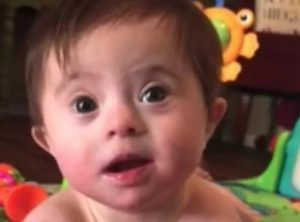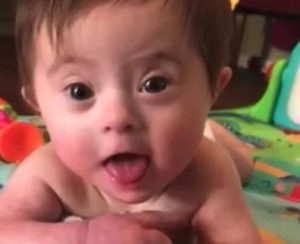It’s very, very hard for a child to live with Down syndrome (DS and the child’s parents suffer a lot to raise the child. In this article, we will see how a baby with down syndrome gave a grin to her mom, and we will see some basics and facts about down syndrome. First of all, what is a down syndrome?
What Is Ds [Down Syndrome]?
Down syndrome is an XY chromosomal disorder in which a child is born with an extra chromosome. Chromosomes are the genetic “packages” that make up the human body. During pregnancy and after delivery, they aid in the shaping and functioning of a baby’s body.
A baby is born with forty-six chromosomes normally. 1 of these chromosomes, chromosome 21, has an extra copy in Down syndrome infants. Trisomy refers to a chromosome having an extra copy. Down syndrome is also known as trisomy 21. This extra copy changes the way the baby’s body and brain develop, resulting in mental and physical issues.
Despite the fact that persons with Down syndrome may act and appear alike, each one has its own set of skills. People with Down syndrome typically have a mild-to-moderately low IQ (intelligence quotient) and speak more slowly than normal kids.
How Did A Baby Give A Grin To Her Mom, And The Whole Internet Started Talking About It?
An adorable baby girl with Down Syndrome gave her new adoptive mother a big grin, which was captured on camera. After being posted on the National Down Syndrome Adoption Network’s Facebook page, the video received hundreds of responses.
Baby H, as she is known due to her anonymity during the adoption process, is now eight months old and stays in Texas with her family.
When asked about her day, Baby H was sleeping on her blanket with her mother, and her beautiful face bloomed into a famous smile.

Credit: facebook.com/MetroUK/
Her mother also revealed in the interview that her Baby H could grin on request. “Oh, I’m fascinated by your new grin!” That is the most lovely! “Can you show me again?” her mother requests in the next part of the video. Naturally, Baby H is overjoyed to hear her mother’s voice and must give her a big smile in return. “Oh my goodness, I like that new smile!” exclaims her mother.

In an interview, her mother stated that her laughter was a reaction to how much she liked her daughter’s smile: “The mom’s laughter shows how much they like her grin, and because she only grinned like this for a few weeks, this footage is a gift for them,” she said.
She and her coworkers believe that everyone will realize the beauty that persons with Down Syndrome have. While receiving a Down Syndrome diagnosis can be frightening, keep in mind that your child was born this way for a reason and will be able to enjoy a long and happy life.
What Are Some Facts About Down Syndrome?

- A person with Down syndrome (DS) is born with an extra copy of chromosome 21. This extra genetic material alters the course of development and is responsible for Down Syndrome.
- While each individual’s behavior, mental aptitude, and physical development differ, many people with Down syndrome go on to work, live independently, and participate in normal life activities.
- The additional chromosome that causes Down syndrome has yet to be identified.
- Down syndrome affects around 25% of families in the United States.
- DS is a very common chromosomal condition in the United States, impacting one in every 691 babies born.
- With maternal age, the chances of having a child with Down syndrome increase.; nevertheless, because this age group gives birth the most frequently, 80 percent of kids with Down syndrome are born to women under 35 years of age.
- Over 400,000 persons in the United States have Down syndrome.
- In the US alone, it is calculated that 5,000 infants are born with Down syndrome.
- A baby with Down syndrome had a 25-year average life expectancy in 1983. It is now 60 years old.
- Public schools have been required by law to provide free and suitable education to children with Down syndrome since the 1970s.
- Children and adults with Down syndrome have certain similarities, although they will naturally resemble their immediate family members.
What Are Some Physical Features Of Down Syndrome?

- Flattening of the face, particularly the bridge of the nose
- Eyes that are almond-shaped and tilt-up
- A slender neck
- Ears that are little
- A tongue that sticks out of the mouth
- There are tiny white specks on the iris (colored part) of the eye.
- Hands and feet are little.
- A single line on the palm of the hand
- Pinky fingers that bend toward the thumb on occasion
- Muscle atrophy or sagging joints
- As children and adults, they are shorter in stature.
What Are The Types Of Down Syndrome?

Down syndrome is divided into three categories. Because the physical characteristics and behaviors of each kind are so similar, most people can’t detect the difference without looking at the chromosomes.
Trisomy 21: Around 95percent of people with Down syndrome have trisomy 21.2. In this type of Down syndrome, instead of the usual two copies of chromosome 21, each cell in the body contains three copies of chromosome 21.
Translocation Down syndrome: Only a small fraction of Down syndrome sufferers are of this type. This occurs when an extra section or entire extra chromosome 21 exists, but it is attached or “trans-located” to another chromosome rather than being a separate chromosome 21.
Mosaic Down syndrome: Mosaic Down syndrome is a kind of Down syndrome that affects roughly 2% of people with the condition. A mosaic is a term used to describe a mixture or combination of items. In children with mosaic Down syndrome, some cells have three copies of chromosome 21, while others have only two copies. Mosaic Down syndrome patients may share many of the same traits as other Down syndrome youngsters. They may show fewer symptoms of the sickness because of the presence of some (or many) cells with a normal number of chromosomes.
That’s all for today. We hope you became happy knowing about the child who gave her mom a grin, as well as you learned some new things about down syndrome.
Read also:China Earthquake: Rescuers Save A 3-Month-Old Infant


